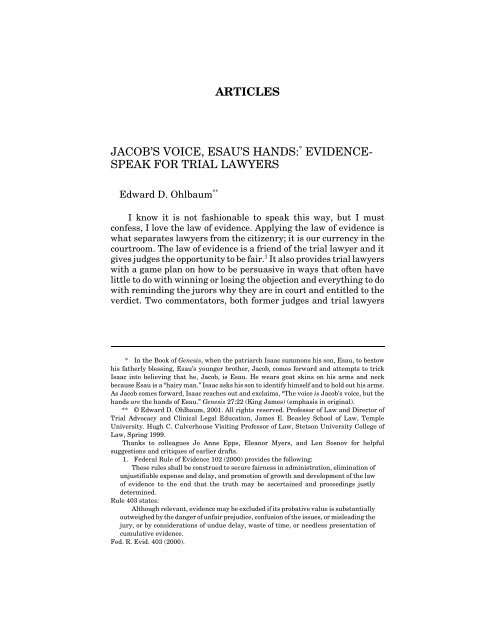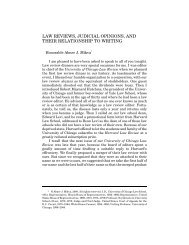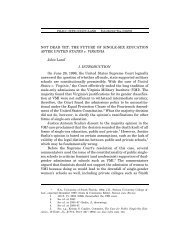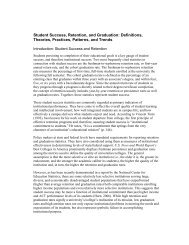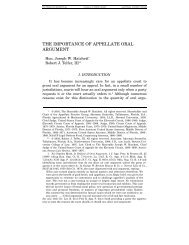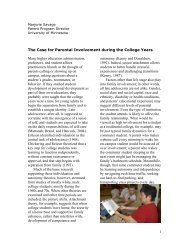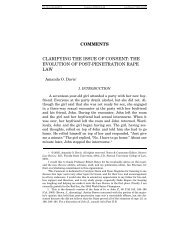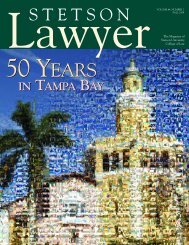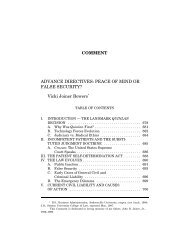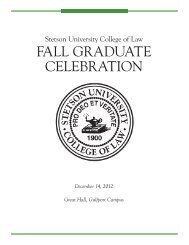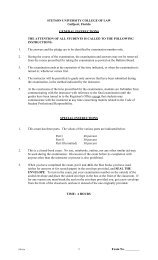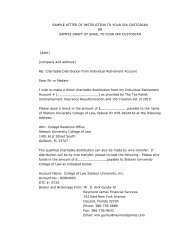Evidence-speak for Trial Lawyers - Stetson University College of Law
Evidence-speak for Trial Lawyers - Stetson University College of Law
Evidence-speak for Trial Lawyers - Stetson University College of Law
You also want an ePaper? Increase the reach of your titles
YUMPU automatically turns print PDFs into web optimized ePapers that Google loves.
ARTICLESJACOB’S VOICE, ESAU’S HANDS: * EVIDENCE-SPEAK FOR TRIAL LAWYERSEdward D. Ohlbaum **I know it is not fashionable to <strong>speak</strong> this way, but I mustconfess, I love the law <strong>of</strong> evidence. Applying the law <strong>of</strong> evidence iswhat separates lawyers from the citizenry; it is our currency in thecourtroom. The law <strong>of</strong> evidence is a friend <strong>of</strong> the trial lawyer and itgives judges the opportunity to be fair. 1 It also provides trial lawyerswith a game plan on how to be persuasive in ways that <strong>of</strong>ten havelittle to do with winning or losing the objection and everything to dowith reminding the jurors why they are in court and entitled to theverdict. Two commentators, both <strong>for</strong>mer judges and trial lawyers* In the Book <strong>of</strong> Genesis, when the patriarch Isaac summons his son, Esau, to bestowhis fatherly blessing, Esau’s younger brother, Jacob, comes <strong>for</strong>ward and attempts to trickIsaac into believing that he, Jacob, is Esau. He wears goat skins on his arms and neckbecause Esau is a “hairy man.” Isaac asks his son to identify himself and to hold out his arms.As Jacob comes <strong>for</strong>ward, Isaac reaches out and exclaims, “The voice is Jacob’s voice, but thehands are the hands <strong>of</strong> Esau.” Genesis 27:22 (King James) (emphasis in original).** © Edward D. Ohlbaum, 2001. All rights reserved. Pr<strong>of</strong>essor <strong>of</strong> <strong>Law</strong> and Director <strong>of</strong><strong>Trial</strong> Advocacy and Clinical Legal Education, James E. Beasley School <strong>of</strong> <strong>Law</strong>, Temple<strong>University</strong>. Hugh C. Culverhouse Visiting Pr<strong>of</strong>essor <strong>of</strong> <strong>Law</strong>, <strong>Stetson</strong> <strong>University</strong> <strong>College</strong> <strong>of</strong><strong>Law</strong>, Spring 1999.Thanks to colleagues Jo Anne Epps, Eleanor Myers, and Len Sosnov <strong>for</strong> helpfulsuggestions and critiques <strong>of</strong> earlier drafts.1. Federal Rule <strong>of</strong> <strong>Evidence</strong> 102 (2000) provides the following:These rules shall be construed to secure fairness in administration, elimination <strong>of</strong>unjustifiable expense and delay, and promotion <strong>of</strong> growth and development <strong>of</strong> the law<strong>of</strong> evidence to the end that the truth may be ascertained and proceedings justlydetermined.Rule 403 states:Although relevant, evidence may be excluded if its probative value is substantiallyoutweighed by the danger <strong>of</strong> unfair prejudice, confusion <strong>of</strong> the issues, or misleading thejury, or by considerations <strong>of</strong> undue delay, waste <strong>of</strong> time, or needless presentation <strong>of</strong>cumulative evidence.Fed. R. Evid. 403 (2000).
C:\MyFiles\book\Articles.311\Galleys\Ohlbaum5.drb.wpd8 <strong>Stetson</strong> <strong>Law</strong> Review [Vol. XXXIand current evidence teachers — one <strong>of</strong> whom is an author in thisSymposium 2 — put it well:The Rules bring real life, with its strengths and weaknesses,into a courtroom, to be presented, in most cases, to an untrainedaudience. The audience will create its own version <strong>of</strong> the story<strong>of</strong> the case, reflecting each member’s life experiences andintelligence. 3Temple <strong>University</strong> has given me a lifetime contract to teachevidence, and I delight in writing, consulting, and talking about thelaw <strong>of</strong> evidence — probably far too much <strong>for</strong> my own, my students’,or anyone else’s good. Like many meaningful relationships, my love<strong>of</strong> evidence did not start out this way. I had to work to understandit and learn how to handle and celebrate its opportunities throughmy own voice.I started my career as a public defender, where the in<strong>for</strong>malcult lines were drawn between the “trial lawyers” and the “lawmen.”As trial lawyers, we did not have time <strong>for</strong> substantive, procedural,or evidentiary law unless it directly and specifically insinuated itselfin our cases. We were busy with the facts — the who did what towhom, when, why, and by what means; the states <strong>of</strong> events and <strong>of</strong>mind; and what people did, felt, imagined, knew, believed, andthought. Pr<strong>of</strong>essor Michael E. Tigar captures this trial lawyergestalt by recounting the advice that an old-school warhorse gave toa court-bound rookie carrying a volume <strong>of</strong> cases under each arm:“Throw away those books boy. Go get yourself a witness.” 4 And so wedid — gladly.Having left full-time practice <strong>for</strong> full-time teaching, I have beenable to take the time to develop a more mature relationship with thelaw <strong>of</strong> evidence. I now recognize that evidentiary principles <strong>of</strong> laware <strong>of</strong>ten the bedrock <strong>of</strong> persuasive advocacy <strong>for</strong> two reasons. First,the law <strong>of</strong> evidence is analytically integrated with the law <strong>of</strong> trialadvocacy. This is not because, given a fair hearing, the lawyer whogrounds objections, <strong>of</strong>fers <strong>of</strong> pro<strong>of</strong>, and motions in limine on the law<strong>of</strong> evidence is more likely to control the pro<strong>of</strong>s; rather, it is because2. Warren D. Wolfson, <strong>Evidence</strong> Advocacy — The Judge’s Perspective, 31 <strong>Stetson</strong> L. Rev.35 (2001).3. Thomas A. Mauet & Hon. Warren D. Wolfson, <strong>Trial</strong> <strong>Evidence</strong> § 1.1., 1–2 (Aspen L. &Bus. 1997).4. Michael E. Tigar, Voices Heard in Jury Argument: Litigation and the <strong>Law</strong> SchoolCurriculum, 9 Rev. Litig. 177, 177 (1990).
C:\MyFiles\book\Articles.311\Galleys\Ohlbaum5.drb.wpd2001] <strong>Evidence</strong>-<strong>speak</strong> <strong>for</strong> <strong>Trial</strong> <strong><strong>Law</strong>yers</strong> 9the analytical underpinnings <strong>of</strong> the respective evidentiary rules andprinciples provide key elements <strong>of</strong> persuasion. <strong>Trial</strong> lawyers whoarticulate these evidentiary principles in their questions andspeeches become more persuasive advocates simply because many<strong>of</strong> the principles on which the rules <strong>of</strong> evidence are based are thesame principles that govern persuasive courtroom per<strong>for</strong>mance.Second, evidentiary concepts are fundamentally interconnectedto trial advocacy principles. The relationship between evidence andtrial advocacy enables the advocate to demonstrate how an underlyingevidentiary principle makes his or her presentation morebelievable, and it permits the advocate to make an opponent pay aprice <strong>for</strong> having abused or disregarded the relationship. Tryingcases is principally about asking questions and making speeches. Todo so persuasively requires the type <strong>of</strong> two-pronged approach thatconfronted the patriarch Isaac — the hands-on discipline <strong>of</strong> theadvocate and the voice 5 <strong>of</strong> the evidence teacher.In its broadest sense, the law <strong>of</strong> evidence is composed <strong>of</strong> rules<strong>of</strong> evidence and those rules <strong>of</strong> procedure, decisional law, andstatutes that govern the pro<strong>of</strong>s. 6 The policies, concepts, andprinciples that underlie the rules are invariably rooted in whatmight be called the law <strong>of</strong> trial advocacy or the techniques <strong>of</strong>persuasion.Stated another way, the trial lawyer who understands whata rule or statute is designed to protect or prohibit is a morepersuasive advocate <strong>for</strong> three reasons. First, challenges to admissibility— commonly called objections, motions in limine, and <strong>of</strong>fers <strong>of</strong>pro<strong>of</strong> — are opportunities to argue how a particular piece <strong>of</strong>evidence either introduces extraneous and unreliable issues orsupports counsel’s theory <strong>of</strong> the case. While this discussion <strong>of</strong>tentakes place at the bench, it also may occur in front <strong>of</strong> the jury.Regardless <strong>of</strong> whether the evidence is ultimately admitted, makingand meeting objections is the trial lawyer’s opportunity to ultimatelypersuade the fact-finder as to why the evidence is(un)reliable, (un)believable, and (un)supportive <strong>of</strong> counsel’s position.Next, evidentiary considerations that craft and shape examinationsare likely to be more persuasive because the respective foundation<strong>for</strong> admissibility contains touchstones <strong>for</strong> persuasion. Finally,5. See Julius G. Getman, Colloquy: Human Voice in Legal Discourse: Voices, 66 Tex. L.Rev. 577, 577–579 (1988) (describing the “pr<strong>of</strong>essional voice <strong>of</strong> legal education”).6. Kenneth S. Broun et al., McCormick on <strong>Evidence</strong> vol. 1, § 1, 2 (John William Stronged., 4th ed., West 1992).
C:\MyFiles\book\Articles.311\Galleys\Ohlbaum5.drb.wpd10 <strong>Stetson</strong> <strong>Law</strong> Review [Vol. XXXIspeeches provide the plat<strong>for</strong>m to teach the jury why, and preciselyhow, the governing principles or the purposes <strong>of</strong> the applicable rulesunderscore the reliability <strong>of</strong> counsel’s presentation. Speeches alsotell why, in certain cases, these principles and policies discredit anddisadvantage opposing counsel who choose to ignore them.For many courtroom lawyers, evidence is regarded as anobstacle to avoid, rather than an opportunity to persuade. Bothobjecting and pr<strong>of</strong>fering inevitably invite the advocate to discuss thepurpose or relevance <strong>of</strong> the evidence in question. To persuade thejudge to exclude or include evidence, the trial lawyer must summarizethe projected pro<strong>of</strong>, its evidentiary basis or lack there<strong>of</strong>, andmost important, its projected impact on the case. Making andmeeting objections provide recurring opportunities to re-argue thecase as it relates to the evidence that is subject to scrutiny. Yet, triallawyers customarily approach evidence like the mythological Greeksapproached the three-headed Cerberus who stood guard at Hades —humbly, deftly, and with trepidation — hoping to ultimately survive,but expecting to be harmed in the process. Believing that bothjudges and juries disfavor objections, many lawyers only object whennecessary to protect the record.The Federal Rules <strong>of</strong> <strong>Evidence</strong> are designed to ensure thaterrors are resolved at trial and that verdicts are upheld. 7 Rule 103is a reminder that appellate relief will not occur unless evidentiaryerror involves substantial or constitutional rights. 8 The rules placethe obligation on the trial lawyer to initiate the en<strong>for</strong>cement processby objecting “timely,” or when an error first becomes apparent.Where error is not called to the court’s attention, any right to reliefis waived.There is an inherent tension between trial judges and lawyersabout how much <strong>of</strong> the objection or <strong>of</strong>fer-<strong>of</strong>-pro<strong>of</strong> dialogue counselmay conduct in front <strong>of</strong> the jury. The rules provide <strong>for</strong> sidebarconferences “to prevent inadmissible evidence from being suggestedto the jury by any means, such as making statements or <strong>of</strong>fers <strong>of</strong>pro<strong>of</strong>.” 9 Yet, trial lawyers frequently are asked by both judges andeach other to defend or explain the basis <strong>of</strong> an objection or <strong>of</strong>fer inopen court. When such an invitation to <strong>speak</strong> is issued, it would beimpolite and certainly imprudent to refuse. I have written elsewhere7. Edward D. Ohlbaum, Objections and Offers: Tell It Again, Sam, 25 Litig. 8, 8 (Spring1999).8. Fed. R. Evid. 103(a) (2000) (“Error may not be predicated upon a ruling . . . unless asubstantial right <strong>of</strong> the party is affected . . . .”).9. Fed. R. Evid. 103(c) (emphasis added).
C:\MyFiles\book\Articles.311\Galleys\Ohlbaum5.drb.wpd2001] <strong>Evidence</strong>-<strong>speak</strong> <strong>for</strong> <strong>Trial</strong> <strong><strong>Law</strong>yers</strong> 11about legal, ethical, and tactical considerations that shape the triallawyer’s decision about where, when, and how to object andpr<strong>of</strong>fer. 10 Yet, regardless <strong>of</strong> whether the evidence skirmish occurs atsidebar or be<strong>for</strong>e the jury, the advocate’s job is to guide, teach, andpersuade. Many judges also listen <strong>for</strong> the buzzword or ritualisticincantation with which they are familiar, but that jurors findunintelligible. Yet, popular adages, such as “not <strong>of</strong>fered <strong>for</strong> the truth<strong>of</strong> the matter asserted” and “lack <strong>of</strong> foundation,” add little morethan confusion. Some catchphrases are simply meaningless, such asthe phrase “res gestae.” 11The phrase res gestae has long been not only entirelyuseless, but even positively harmful. It is useless, because everyother rule <strong>of</strong> evidence to which it has ever been applied exists asa part <strong>of</strong> some other well-established principle and can beexplained in the terms <strong>of</strong> that principle. It is harmful, becauseby its ambiguity it invites the confusion <strong>of</strong> one rule with anotherand thus creates uncertainty as to the limitations <strong>of</strong> both. Itought there<strong>for</strong>e wholly to be repudiated as a vicious element inour legal phraseology. No rule <strong>of</strong> evidence can be created orapplied by the mere muttering <strong>of</strong> a shibboleth. There are wordsenough to describe the rules <strong>of</strong> evidence. Even if there were noaccepted name <strong>for</strong> one or another doctrine, any name would bepreferable to an empty phrase so encouraging to looseness <strong>of</strong>thinking and uncertainty <strong>of</strong> decision. 1210. Edward D. Ohlbaum, Basic Instinct: Case Theory and Courtroom Per<strong>for</strong>mance, 66Temple L. Rev. 1, 44–55 (1993); Ohlbaum, supra n. 7, at 1.11. Black’s <strong>Law</strong> Dictionary 1173 (5th ed., West 1979) (defining “res gestae” as “literallythings or things happened and there<strong>for</strong>e, to be admissible as exceptions to the hearsay rule,words spoken, thoughts expressed, and gestures made, must all be so closely connected tooccurrence or event in both time and substance as to be part <strong>of</strong> the happening”).12. John Henry Wigmore, <strong>Evidence</strong> in <strong>Trial</strong>s at Common <strong>Law</strong> vol. 6, § 1767, 255 (JamesH. Chadbourn ed., Aspen L. & Bus. 1976). Although the courts still use the phrase “resgestae,” many judges have condemned the phrase. For example,Holmes, J.: “The man that uses that phrase shows that he has lost temporarily allpower <strong>of</strong> analyzing ideas.” J.B. Thayer’s memo books as cited by E.R. Thayer in histeaching notes recording a report by Samuel Williston (1895). L. Hand, J.: “[A]s <strong>for</strong> ‘resgestae’ . . . if it means anything but an unwillingness to think at all, what it coverscannot be put in less intelligible terms.” [Melvin, J.:] “Definitions <strong>of</strong> res gestae are asnumerous as the prescriptions <strong>for</strong> the cure <strong>of</strong> rheumatism and generally about asuseful.”Michael M. Martin, Basic Problems <strong>of</strong> <strong>Evidence</strong> § 13.06, 357 n. 174 (6th ed., ALI 1988)(internal citations omitted, emphasis in original).
C:\MyFiles\book\Articles.311\Galleys\Ohlbaum5.drb.wpd12 <strong>Stetson</strong> <strong>Law</strong> Review [Vol. XXXIMany <strong>of</strong> these phrases, such as “<strong>of</strong>fered merely because it wassaid,” are bewildering at best. Still others convey a misunderstandingand misapplication <strong>of</strong> a rule, like “the document <strong>speak</strong>s <strong>for</strong>itself.” 13 In the tournament <strong>of</strong> skill held within the courtroom arena,there is little understanding <strong>of</strong>, less appreciation <strong>for</strong>, and only rareapplication <strong>of</strong> the law <strong>of</strong> evidence as an armament <strong>of</strong> persuasion.<strong>Trial</strong> lawyers become persuasive when they take the time tounderstand the rules and to translate them into intelligible soundbites that advance counsel’s theory.I. OBJECTIONS AND OFFERSToo <strong>of</strong>ten, lawyers adopt an objection strategy that is principallydirected to protecting the “record” <strong>for</strong> appeal, but that pays littleconsideration to the objection’s effect on the jury. Ever fearful <strong>of</strong>failing to preserve evidentiary error <strong>for</strong> appellate court consideration,a lawyer’s mission is to make sure that the court reporter hasrecorded his or her objection to any judicial blunder, mistake, orimpropriety that might conceivably bring relief. But even whereobjections have been properly preserved, 14 the chances <strong>of</strong> appellaterelief are — as the old joke goes — two: slim and none. As thenChief Judge William J. Bauer <strong>of</strong> the United States Court <strong>of</strong> Appeals<strong>for</strong> the Seventh Circuit put it with literary concision:We review the district court’s determination <strong>for</strong> abuse <strong>of</strong>discretion, noting that “appellants who challenge evidentiaryrulings <strong>of</strong> the district court are like rich men who wish to enterthe Kingdom: their prospects compare with those <strong>of</strong> camels whowish to pass through the eye <strong>of</strong> the needle.” 1513. The phrase loosely refers to Federal Rule <strong>of</strong> <strong>Evidence</strong> 1002 (2000), a rule <strong>of</strong>admissibility that states that when the contents <strong>of</strong> a document are material or significant, thewriting must be <strong>of</strong>fered. However, once the document is admitted, it may be published ordisplayed to the jury, subject to the discretion <strong>of</strong> the court, in a variety <strong>of</strong> ways, such as byreading it, displaying it on an overhead, or providing individual copies to the jurors.Secondary evidence <strong>of</strong> the contents — i.e., what a witness recalls about the contents — isadmissible only when the document is unavailable through no fault <strong>of</strong> the proponent. Fed. R.Evid. 1004 (2000).14. The law governing objections is set <strong>for</strong>th in Federal Rule <strong>of</strong> <strong>Evidence</strong> 103. Toadequately preserve an evidentiary error <strong>for</strong> appeal, an objection must be timely and specific(unless it is “plain”), the error must affect a party’s “substantial right,” and the evidence maynot be admissible on any other basis. Fed. R. Evid. 103.15. U.S. v. Coleman, 179 F.3d 1056, 1061 (7th Cir. 1999) (quoting U.S. v. Emenogha, 1F.3d 473, 477 (7th Cir. 1993) (quoting U.S. v. Glecier, 923 F.2d 496, 503 (7th Cir. 1991))).
C:\MyFiles\book\Articles.311\Galleys\Ohlbaum5.drb.wpd2001] <strong>Evidence</strong>-<strong>speak</strong> <strong>for</strong> <strong>Trial</strong> <strong><strong>Law</strong>yers</strong> 13The time to win is at trial. 16 Objections and <strong>of</strong>fers <strong>of</strong> pro<strong>of</strong>should be articulated, not as the first step in a precarious journeythrough an appellate quagmire, but as a persuasive speech to a factfinderabout how specific evidence substantiates counsel’s theoryand negates his or her opponent’s theory <strong>of</strong> the case. Where thecourt does not prohibit brief <strong>speak</strong>ing objections and <strong>of</strong>fers 17 —whether in front <strong>of</strong> the jury or at sidebar — the objection dialogueis the lawyer’s opportunity to articulate how an evidentiary concepthelps answer a specific question. By addressing the value or policythat drives the evidentiary principle at issue, the lawyer’s pitchbecomes more persuasive.As I wrote in another context:Both objecting and pr<strong>of</strong>fering inevitably invite the advocate todiscuss the purpose or relevance <strong>of</strong> the evidence in question. Topersuade the judge to exclude or include evidence, the triallawyer must summarize the projected pro<strong>of</strong>, its evidentiarybasis or lack there<strong>of</strong>, and, most importantly, its projectedimpact on the case. Stated another way, both objections and<strong>of</strong>fers <strong>of</strong> pro<strong>of</strong> summon the trial lawyer to present the casetheory as it relates to the evidence that is subject to scrutiny.Although cast in the context <strong>of</strong> legal argument, objections and16. Mauet & Wolfson, supra n. 3, at § 1.1., 1 n. 1 (citing Margaret A. Berger, When IfEver, Does Evidentiary Error Constitute Reversible Error?, 25 Loy. L.A. L. Rev. 893 (1992)(“where the author found 30 reversals based on evidentiary error in the federal district courtsduring 1990 — 17 in civil cases, 13 in criminal cases — from a total <strong>of</strong> more than 10,000 casestried”)).17. That lawyers seek to deliver what have been branded mini-closing speeches is notonly understandable, but is promoted by the law <strong>of</strong> evidence and advocacy. These speechesare what the decisional law invites and what the law <strong>of</strong> advocacy encourages. Significantly,notwithstanding the folklore, appellate courts have admonished trial counsel <strong>for</strong> saying toolittle, rather than too much. Repeatedly, counsel have been admonished not to assume thatthe court is familiar with the theory and to err on the side <strong>of</strong> full rather than limitedexposition. See generally Beech Aircraft Corp. v. Rainey, 488 U.S. 153, 174 (1988) (stating thatan <strong>of</strong>fer <strong>of</strong> pro<strong>of</strong> <strong>for</strong> preserving any argument to exclude evidence must be apparent from thecontext <strong>of</strong> the questions asked); U.S. v. Santos, 932 F.2d 244, 254 (3d Cir. 1991) (holding thatthe standard <strong>of</strong> review <strong>for</strong> specific objections raised on appeal is “plain” error); Reese v.Mercury Marine Div. <strong>of</strong> Brunswick Corp., 793 F.2d 1416, 1421 (5th Cir. 1986) (stating thatFederal Rule <strong>of</strong> <strong>Evidence</strong> 103(a)(2) requires counsel to specifically articulate the grounds <strong>for</strong>admitting evidence); U.S. v. Garcia, 531 F.2d 1303, 1307 (5th Cir. 1976) (holding thatobjections will be reversed only on “plain” error); U.S. v. Madruga, 810 F.2d 1010, 1014 (11thCir. 1987) (stating that the grounds <strong>for</strong> an underlying objection must be specific, but not a“ritualistic incantation”). Notwithstanding the absence <strong>of</strong> a specificity requirement in Rule103(a)(2), by “<strong>of</strong>fering to prove” evidence, counsel is obligated to state the specific grounds <strong>for</strong>admissibility as Rule 103(a)(1) requires him or her to do when making objections. Fed. R.Evid. 103(a).
C:\MyFiles\book\Articles.311\Galleys\Ohlbaum5.drb.wpd14 <strong>Stetson</strong> <strong>Law</strong> Review [Vol. XXXI<strong>of</strong>fers provide trial counsel with opportunities to argue facts inan ef<strong>for</strong>t to persuade the judge to accept the lawyer’s theory inmaking evidentiary rulings. It is the trial lawyer’s opportunityto make a speech about how specific evidence substantiates thelawyer’s case theory and negates the case theory <strong>of</strong> theopponent. 18A. HearsayThe typical “hearsay” exchange provides counsel with theopportunity to persuade by referring to evidentiary principles. Anout-<strong>of</strong>-court statement may be subject to the hearsay prohibitiononly when the statement is <strong>of</strong>fered <strong>for</strong> the truth <strong>of</strong> its specificcontents. 19 Of course, an out-<strong>of</strong>-court statement may be admitted <strong>for</strong>its truth if it falls within a hearsay exception. 20 The typical hearsayexchange proceeds as follows:Q: What did she tell you?A: She told me that she was going to . . . .O: Objection, hearsay.Q: Not <strong>of</strong>fered <strong>for</strong> the truth <strong>of</strong> the matter asserted.This colloquy has been remarkably unhelpful to the judge and,to put it most charitably, virtually unintelligible to the jury. Todecide whether a statement is admissible <strong>for</strong> a nonhearsay purpose,is defined as nonhearsay, or fits within a hearsay exception, thejudge invariably needs to know the contents <strong>of</strong> the statement.Without that knowledge, the judge has ceded the determination <strong>of</strong>18. Ohlbaum, supra n. 7, at 10.19. Under the Federal Rules <strong>of</strong> <strong>Evidence</strong>, there are a variety <strong>of</strong> statements that aredefined as nonhearsay and, thus, exempt from the hearsay prohibition. Such statementsinclude prior inconsistent statements taken under oath and subject to perjury, priorconsistent statements, statements <strong>of</strong> identification, and admissions. Fed. R. Evid. 801(d)(1),(2) (2000).20. The hearsay exceptions are found in Federal Rules <strong>of</strong> <strong>Evidence</strong> 803, 804, and 807. SeeFed. R. Evid. 803 (2000) (giving exceptions to the hearsay rule even though the declarantis available); Fed. R. Evid. 804 (2000) (allowing exceptions to the hearsay rule when thedeclarant is unavailable); Fed. R. Evid. 807 (2000) (allowing an exception to the hearsay rule<strong>for</strong> statements not “covered by Rules 803 or 804 but having equivalent circumstantialguarantees <strong>of</strong> trustworthiness”). States have promulgated statutes, rules <strong>of</strong> procedure, andadditional rules <strong>of</strong> evidence providing other hearsay exceptions. E.g. Fla. Stat. § 90.803(2000).
C:\MyFiles\book\Articles.311\Galleys\Ohlbaum5.drb.wpd2001] <strong>Evidence</strong>-<strong>speak</strong> <strong>for</strong> <strong>Trial</strong> <strong><strong>Law</strong>yers</strong> 15admissibility to the lawyer with the right quip, and the jury hasbeen treated as an uninvited interloper.We should give the lawyers a bit more credit and consider thesame type <strong>of</strong> dialogue in one <strong>of</strong> Hollywood’s trial movies, JaggedEdge. 21 In this film, newspaper publisher Jack Forrester wasprosecuted <strong>for</strong> the premeditated murder <strong>of</strong> his wife Paige, co-owner<strong>of</strong> the paper and heiress <strong>of</strong> the publishing empire, because sheintended to divorce him. In support <strong>of</strong> its theory, the prosecutioncalled Virginia Howell, a “friend” <strong>of</strong> the decedent wife, who testifiedas follows:Q: Mrs. Howell, describe your relationship with PaigeForrester, please.A: Well, we were like sisters.Q: What did she say about her relationship with her husband?O: Objection, Your Honor, it calls <strong>for</strong> hearsay.Q: Your Honor, this testimony is being <strong>of</strong>fered to show thestate <strong>of</strong> mind <strong>of</strong> Paige Forrester; there<strong>for</strong>e, it is an exceptionto the hearsay rule.O: Mr. Krazny [the prosecutor] has shown no connectionbetween the state <strong>of</strong> mind <strong>of</strong> Mrs. Forrester and my client,and the charges in this case.J: I will allow it, subject to the connection to Mr. Forrester.Q: Now, Mrs. Howell, what did Paige Forrester say about herrelationship with her husband?A: She knew that he didn’t love her, and she was sure that hewas seeing someone else.Q: And did she tell you anything else?A: She was going to tell her husband that she wanted adivorce. 2221. Jagged Edge (Columbia Pictures 1986) (motion picture). Jagged Edge starred JeffBridges, Glenn Close, Peter Coyote, John Dehner, and Best Supporting Actor Nominee RobertLoggia. Roy Pickard, The Oscar Movies (4th ed., Facts on File 1994).22. Jagged Edge (Columbia Pictures 1986).
C:\MyFiles\book\Articles.311\Galleys\Ohlbaum5.drb.wpd16 <strong>Stetson</strong> <strong>Law</strong> Review [Vol. XXXIResponses to hearsay should be phrased in the affirmative.Rather than telling the judge what the evidence is not <strong>of</strong>fered toprove, tell the court why it should come in — as Krazny did — andwhat the evidence is so that the court may determine whether it isrelevant. Where, as here, counsel names but fails to spell out thenonhearsay purpose or hearsay exception under which the statementis <strong>of</strong>fered, the court is left with counsel’s blackletter<strong>for</strong>malistic pronouncement and the jury is left with lawyer-<strong>speak</strong>.A statement <strong>of</strong>fered to show the declarant’s “state <strong>of</strong> mind” 23 mayqualify <strong>for</strong> admission as nonhearsay evidence <strong>of</strong> a mental state(“There are divorce lawyers lurking in my closets.”) or as anexception to the hearsay rule (“I want a divorce.”). Where thedeclarant expresses a present intention to take future action (“I willask him <strong>for</strong> a divorce.”), the statement is admissible as evidencethat the action was taken as the actor portended. 24 A dialogue inwhich both lawyers may take advantage <strong>of</strong> the policies within thehearsay rule and state-<strong>of</strong>-mind exception might proceed as follows:Q1: Please describe your relationship with Paige Forrester.A: Well, we were like sisters.Q1: What did she say about her relationship with herhusband?Q2: Objection, Your Honor, the question calls <strong>for</strong> hearsay.He is asking the witness to repeat a statement made bysomeone whose credibility this jury cannot evaluate.Q1: This testimony is an exception to the hearsay rulebecause it is <strong>of</strong>fered to show the state <strong>of</strong> mind <strong>of</strong> PaigeForrester. If permitted, Mrs. Howell will testify thatMrs. Forrester told her that she knew the defendant didnot love her and that she was going to tell him that shewanted a divorce. Mrs. Forrester’s statement to herfriend that she planned to tell the defendant shewanted a divorce is evidence not only <strong>of</strong> her desire to23. Federal Rule <strong>of</strong> <strong>Evidence</strong> 803(3) provides the following:A statement <strong>of</strong> the declarant’s then existing state <strong>of</strong> mind, emotion, sensation, orphysical condition (such as intent, plan, motive, design, mental feeling, pain, and bodilyhealth), but not including a statement <strong>of</strong> memory or belief to prove the factremembered or believed unless it relates to the execution, revocation, identification,or terms <strong>of</strong> declarant’s will.24. Mut. Life Ins. Co. v. Hillmon, 145 U.S. 285, 295–300 (1892); Shelden v. Barre BeltGranite Employer Union Pension Fund, 25 F.3d 74, 79 (2d Cir. 1994).
C:\MyFiles\book\Articles.311\Galleys\Ohlbaum5.drb.wpd2001] <strong>Evidence</strong>-<strong>speak</strong> <strong>for</strong> <strong>Trial</strong> <strong><strong>Law</strong>yers</strong> 17end the relationship, but pro<strong>of</strong> that she spoke with thedefendant and made him aware <strong>of</strong> her intentions.A problem with such exchanges is that, where unregulated, theyprovide a license <strong>for</strong> a lawyer to make speeches that may containinadmissible evidence that the jury has no right to hear. Evenwhere the discussion takes place outside the presence <strong>of</strong> the jury, 25trial lawyers should remember that the judge is also a fact-finderwhom they must persuade. Making and meeting objections alsogives a trial lawyer an opportunity to introduce himself or herself tothe judge as an advocate who is familiar with the law, respectful <strong>of</strong>the court’s responsibility to control the gates <strong>of</strong> admissibility, andready to help the judge in defending evidentiary determinations by<strong>of</strong>fering short discourses, which may serve as the basis <strong>of</strong> the judge’sopinion. Regardless <strong>of</strong> whether the evidence is admitted or excluded,judges and juries will assess the trial lawyer and the strength <strong>of</strong> thecase based on the way that counsel objects.B. Other Act <strong>Evidence</strong><strong>Evidence</strong> <strong>of</strong> other and <strong>of</strong>ten unrelated acts, good and bad — andregardless <strong>of</strong> whether they resulted in any criminal or disciplinaryaction — may be admissible <strong>for</strong> a variety <strong>of</strong> very different reasons.For example, evidence that a witness was drinking earlier may be<strong>of</strong>fered to challenge his or her competency to testify, 26 perception <strong>of</strong>an event, 27 or partiality, such as retaliation <strong>for</strong> firing as a result <strong>of</strong>drinking. 28 This evidence also may be used to prove notice or anessential element <strong>of</strong> a claim, 29 such as negligent entrustment orunfitness to parent; 30 to rebut an opponent’s claim, such as <strong>of</strong>25. Federal Rule <strong>of</strong> <strong>Evidence</strong> 103(c) provides the following:In jury cases, proceedings shall be conducted, to the extent practicable, so as toprevent inadmissible evidence from being suggested to the jury by any means, such asmaking statements or <strong>of</strong>fers <strong>of</strong> pro<strong>of</strong> or asking questions in the hearing <strong>of</strong> the jury.26. See Fed. R. Evid. 601 (2000) (noting that, except as stated in the Federal Rules <strong>of</strong><strong>Evidence</strong>, every person is competent to be a witness).27. See Fed. R. Evid. 602 (2000) (stating that a witness may testify only if he or she haspersonal knowledge).28. See Fed. R. Evid. 607 (2000) (“The credibility <strong>of</strong> a witness may be attacked by anyparty . . . .”).29. See Fed. R. Evid. 405(b) (2000) (allowing specific instances <strong>of</strong> a person’s conduct to beadmitted into evidence if his or her character is an element <strong>of</strong> the charge against him or her).30. See Fed. R. Evid. 404(b) (2000) (“<strong>Evidence</strong> <strong>of</strong> other crimes, wrongs, or acts is notadmissible to prove the character <strong>of</strong> a person in order to show action in con<strong>for</strong>mity therewith.”).
C:\MyFiles\book\Articles.311\Galleys\Ohlbaum5.drb.wpd18 <strong>Stetson</strong> <strong>Law</strong> Review [Vol. XXXIwrongful termination or liability; 31 as a component <strong>of</strong> impeachmentby bad acts, such as lying about a drinking problem; <strong>for</strong> a criminalconviction, 32 where being drunk is an element <strong>of</strong> the crime; or aspertinent trait evidence, such as sobriety. 33Federal Rule <strong>of</strong> <strong>Evidence</strong> 404(b) dictates that evidence <strong>of</strong>uncharged conduct is never admissible to prove propensity. 34 Thisprohibition on admissibility is so, not because the evidence isirrelevant, but because <strong>of</strong> the danger that it will be too persuasivein an unfair way. As Justice Robert H. Jackson explained inMichelson v. United States: 35[I]t is said to weigh too much with the jury and to so overpersuadethem as to prejudge one with a bad general record anddeny him a fair opportunity to defend against a particularcharge. The overriding policy <strong>of</strong> excluding such evidence, despiteits admitted probative value, is the practical experience that itsdisallowance tends to prevent confusion <strong>of</strong> issues, unfairsurprise and undue prejudice. 36The risk is so great that any alternative purpose that the prosecutionpr<strong>of</strong>fers — such as intent, preparation, identity, knowledge,motive, opportunity, and absence <strong>of</strong> mistake or accident — must beclearly identified, and the inferences sought to be drawn from theevidence must be precisely specified.A persuasive <strong>of</strong>fer <strong>of</strong> uncharged conduct evidence comes fromanother one <strong>of</strong> Hollywood’s giants, The Caine Mutiny. 37 This film31. See Fed. R. Evid. 608(b) (2000) (allowing counsel to cross-examine a witness concerningspecific instances <strong>of</strong> his or her conduct in order to attack the credibility <strong>of</strong> the witness).32. See Fed. R. Evid. 609 (2000) (allowing evidence <strong>of</strong> a witness’s criminal conviction <strong>for</strong>the purposes <strong>of</strong> impeachment).33. Fed. R. Evid. 404; Fed. R. Evid. 405.34. Fed. R. Evid. 404(b) provides:<strong>Evidence</strong> <strong>of</strong> other crimes, wrongs, or acts is not admissible to prove the character<strong>of</strong> a person in order to show action in con<strong>for</strong>mity therewith. It may, however, beadmissible <strong>for</strong> other purposes, such as pro<strong>of</strong> <strong>of</strong> motive, opportunity, intent, preparation,plan, knowledge, identity, or absence <strong>of</strong> mistake or accident, provided that uponrequest by the accused, the prosecution in a criminal case shall provide reasonablenotice in advance <strong>of</strong> trial, or during trial if the court excuses pretrial notice on goodcause shown, <strong>of</strong> the general nature <strong>of</strong> any such evidence it intends to introduce at trial.35. 335 U.S. 469 (1948).36. Id. at 476 (citing John Henry Wigmore, <strong>Evidence</strong> in <strong>Trial</strong>s at Common <strong>Law</strong> vol. 1, § 57(3d ed., Little, Brown & Co. 1940)).37. The Caine Mutiny (Columbia Pictures 1954) (motion picture). The Caine Mutinystarred Humphrey Bogart, Jose Ferrer, Van Johnson, Fred MacMurray, and E.G. Marshall.Id. The film garnered six Oscar nominations — including Best Picture — and was based on
C:\MyFiles\book\Articles.311\Galleys\Ohlbaum5.drb.wpd2001] <strong>Evidence</strong>-<strong>speak</strong> <strong>for</strong> <strong>Trial</strong> <strong><strong>Law</strong>yers</strong> 19tells the story <strong>of</strong> the court-martial <strong>of</strong> two naval <strong>of</strong>ficers <strong>for</strong> mutinyas a result <strong>of</strong> their displacement <strong>of</strong> their captain, LieutenantCommander Queeg, during a typhoon at sea. Their defense was thatQueeg was deranged. Defense counsel Barney Greenwald’s <strong>of</strong>fer <strong>of</strong>pro<strong>of</strong> during his cross-examination <strong>of</strong> Queeg combined all <strong>of</strong> theelements <strong>of</strong> legal reasoning and persuasive speech.The Court:Greenwald:A word <strong>of</strong> caution be<strong>for</strong>e you proceed with yourexamination, Mr. Greenwald. The court recognizesthat the defense is compelled to try tochallenge the competence <strong>of</strong> LieutenantCommander Queeg. Nevertheless, all therequirements <strong>of</strong> legal ethics and militaryrespect remain in <strong>for</strong>ce.Thank you, Sir.Q: Mr. Queeg, during the period that the Cainewas towing targets, did you ever steam overyour own tow line and cut it?J. Advocate: Objection, I beg the court’s indulgence, but Imust say the defense outrages the dignity <strong>of</strong>this proceeding.Greenwald:The Court:Greenwald:The Judge Advocate wants the defense toswitch to a guilty plea. He thinks the report <strong>of</strong>the psychiatrist closes the case, but I say it isup to you line naval <strong>of</strong>ficers, not doctors, tojudge the captain’s per<strong>for</strong>mance <strong>of</strong> duty, and Imust review that per<strong>for</strong>mance <strong>of</strong> duty <strong>for</strong> thenavy to render a judgment.Objection overruled.Now Sir, did you ever steam over your own towline and cut it? 38This exchange is an example <strong>of</strong> a “big city” cross-examination.Counsel took it right to the witness — without warmup or pleasantries.Notwithstanding that the defense lawyer was wearing theHerman Wouk’s novel. Leslie Halliwell, Halliwell’s Film and Video Guide 1998, at 121 (JohnWalker ed., rev. ed., HarperPerennial 1998).38. The Caine Mutiny (Columbia Pictures 1954).
C:\MyFiles\book\Articles.311\Galleys\Ohlbaum5.drb.wpd20 <strong>Stetson</strong> <strong>Law</strong> Review [Vol. XXXIsame dress blues as the judge, jury, and judge advocate, there is noquestion that, <strong>for</strong> him, this trial was an away game. Any questionabout where the court’s sympathies first lie was resolved by itsinitial admonition to Greenwald. The cross-examination worked sowell because the uncharged conduct <strong>of</strong> cutting the tow line wasplaced in the exact factual context that the court approved.II. EXAMINATIONSQuestioning that respects the rules <strong>of</strong> evidence does not inviteobjection interruptions. Consequently, proper questioning is morelikely to sustain a jury’s focus and, accordingly, is more apt tobe convincing. An objection-free examination is tighter, sharper,clearer, and ultimately more compelling. Stated another way, evidentiaryfoundations are matters <strong>of</strong> both admissibility and persuasion.A. Refreshing RecollectionWhen a witness is unable to testify about specific facts or eventsbecause <strong>of</strong> memory loss, counsel may refresh the witness’s recollectionunder Federal Rule <strong>of</strong> <strong>Evidence</strong> 612. 39 The procedure requiresthe examiner to present the witness with a device <strong>for</strong> review —generally the witness’s earlier statement or testimony — in an ef<strong>for</strong>tto help the witness remember a <strong>for</strong>gotten fact. Any document may39. Federal Rule <strong>of</strong> <strong>Evidence</strong> 612 (2000) states,Except as otherwise provided in criminal proceedings by section 3500 <strong>of</strong> title 18,United States Code, if a witness uses a writing to refresh memory <strong>for</strong> the purpose <strong>of</strong>testifying, either —(1) while testifying, or(2) be<strong>for</strong>e testifying, if the court in its discretion determines it is necessary in theinterests <strong>of</strong> justice, an adverse party is entitled to have the writing produced at thehearing, to inspect it, to cross-examine the witness thereon, and to introduce inevidence those portions which relate to the testimony <strong>of</strong> the witness. If it is claimedthat the writing contains matters not related to the subject matter <strong>of</strong> the testimony thecourt shall examine the writing in camera, excise any portions not so related, and orderdelivery <strong>of</strong> the remainder to the party entitled thereto. Any portion withheld overobjections shall be preserved and made available to the appellate court in the event <strong>of</strong>an appeal. If a writing is not produced or delivered pursuant to order under this rule,the court shall make any order justice requires, except that in criminal cases when theprosecution elects not to comply, the order shall be one striking the testimony or, if thecourt in its discretion determines that the interests <strong>of</strong> justice so require, declaring amistrial.
C:\MyFiles\book\Articles.311\Galleys\Ohlbaum5.drb.wpd22 <strong>Stetson</strong> <strong>Law</strong> Review [Vol. XXXIWhen a witness reads a document out <strong>of</strong> context, the opponent may<strong>of</strong>fer any other part <strong>of</strong> the document or any other document thatrestores the context and “ought in fairness to be consideredcontemporaneously with it.” 44 While the rule applies to a variety <strong>of</strong>writings, 45 it is most <strong>of</strong>ten raised when a prior inconsistent statementis used to impeach a witness. As an alternative to delayedgratification, the rule permits the opponent to <strong>of</strong>fer additionaldocumentation during the impeachment. 46 For example, when awitness is challenged with an earlier statement or transcription <strong>of</strong>testimony in which the witness had taken a different position fromhis or her trial testimony, the rule permits the opposing lawyer tointroduce another section from the statement or transcript — or anyother document — that may help the witness explain the apparentinconsistency. 47A tight and crisply executed impeachment by an inconsistentstatement requires a witness to admit that he or she made astatement — it does not permit a witness to explain why he or shesaid it. Notwithstanding a cross-examination that provides room <strong>for</strong>the witness to say only, “Yes, I said it,” or “No, I did not say that,”judges <strong>of</strong>ten permit a challenged witness to explain the inconsistentstatement during cross-examination. When the witness eitherdenies making, or attempts to explain, the inconsistency, any part<strong>of</strong> that statement — or any other statement from the witness thatsupports the denial or explanation — may be admissible during theimpeachment. 48 By giving opposing counsel the opportunity tointerrupt an impeachment and insist on introducing the completedocument or other writing, Rule 106 provides the witness withadditional protection against the misuse <strong>of</strong> his or her earlierstatement. 49 A lawyer who gets caught misleading a jury during thecontemporaneously with it.44. Fed. R. Evid. 106.45. Popular examples <strong>of</strong> writings include prior statements, recorded recollections,business and <strong>of</strong>ficial records, miscellaneous <strong>of</strong>ficial records, and summaries. See generallyFed. R. Evid. 612 (giving requirements <strong>for</strong> a witness to use a writing to refresh his or hermemory); Fed. R. Evid. 613 (2000) (stating that a witness does not have to be shown his orher prior statement when examined as to that statement); Fed. R. Evid. 801 (giving theapplicable definitions under the hearsay rule); Fed. R. Evid. 803 (giving examples <strong>of</strong> writingsthat fall under hearsay exceptions); Fed. R. Evid. 1006 (2000) (stating that any writings thatcannot be conveniently examined due to the volume <strong>of</strong> the writing may be summarized).46. Fed. R. Evid. 106.47. Id.; Fed. R. Evid. 613(b).48. Fed. R. Evid. 106.49. Id.
C:\MyFiles\book\Articles.311\Galleys\Ohlbaum5.drb.wpd2001] <strong>Evidence</strong>-<strong>speak</strong> <strong>for</strong> <strong>Trial</strong> <strong><strong>Law</strong>yers</strong> 23impeachment <strong>of</strong> a witness by inaccurately, incompletely, or unfairlyquoting from a document succeeds in simultaneously rehabilitatingthe witness and discrediting himself or herself.When a witness is impeached with an inconsistent statement,many lawyers reflexively and abusively invoke Rule 106. Theselawyers are <strong>of</strong>ten successful, even though the statement has notbeen read out <strong>of</strong> context. 50 Where the witness’s explanation ispersuasive and the supporting documentation is plainly helpful,simply reading the earlier statement may better serve impeachingcounsel — assuming the document is independently admissible. 51When examining counsel impeaches a witness with a statementthat has been taken out <strong>of</strong> context and there is additional documentationthat tends to support the witness’s explanation or denial <strong>of</strong>the statement, the rule <strong>of</strong> completeness does not require counsel tocorrect it on the spot. 52 However, patience pays <strong>of</strong>f because opposingcounsel’s strong-arm tactics may result in self-strangulation. Whencounsel impeaches a witness with an out-<strong>of</strong>-context or less-thancompletestatement and cuts <strong>of</strong>f the witness’s attempted explanation,a redirect examination — guided by the policy <strong>of</strong> Rule 106 —can be especially lethal, as the following vignette illustrates:Q: During cross-examination, counsel asked you about astatement you made in your deposition about the telephonecall. When you began to explain to him what you meant, heinterrupted your answer and told you that you will have theopportunity to explain later. That time is here, so I amgoing to ask you some questions that now allow you to dojust that. First, please pick up your deposition and turn topage seventy-six, lines eight through ten, which is theanswer that counsel asked you about.Please read those lines — the lines that counsel asked youto read.A: [Reads lines]50. Reliance on Federal Rule <strong>of</strong> <strong>Evidence</strong> 801(d)(1)(B) to <strong>of</strong>fer the statements as priorconsistent statements also is misplaced when the statements in dispute do not precede andthus cannot rebut any motive to lie. Tome v. U.S., 513 U.S. 150, 158 (1995).51. For example, an “admission” would be independently admissible. Fed. R. Evid.801(d)(2). If the witness is not a party, Rule 613 requires counsel to confront the witness withthe earlier statement and give the witness an opportunity to “explain or deny” theinconsistency be<strong>for</strong>e extrinsic evidence is admissible. Fed. R. Evid. 613(b).52. Fed. R. Evid. 106.
C:\MyFiles\book\Articles.311\Galleys\Ohlbaum5.drb.wpd24 <strong>Stetson</strong> <strong>Law</strong> Review [Vol. XXXIQ: Did your answer end there?A: No.Q: Please read the rest <strong>of</strong> your answer.A: [Reads additional lines]Q: Were those the lines that you began to read when counselasked you to stop reading?A: Yes.Q: Please turn to page eighty-six, lines twenty to twenty-five.Is that where you also discussed the telephone call?A: Yes.Q: In response to counsel’s question, which was, “And that wasall you discussed during the telephone call?,” please readyour answer.A: [Reads lines]Q: Did counsel ask you about this passage when he questionedyou today?A: No.Q: Please tell us what you said about your requirements in thetelephone conversation.Federal Rule <strong>of</strong> <strong>Evidence</strong> 106 puts the impeaching lawyer onnotice that the rest <strong>of</strong> the writing or statement may be introduced. 53Counsel’s “fairness” during the impeachment <strong>of</strong> a witness with aninconsistent statement is a relevant consideration and may triggeran interruption in the flow <strong>of</strong> an examination, the admission <strong>of</strong>rebutting evidence, and perhaps most important, an examination <strong>of</strong>counsel’s fairness in challenging the witness. Under Rule 106,counsel may use writings, “which ought in fairness to be considered,”54 to help a witness do the following: (1) explain the acknowledgedinconsistency or support the denial <strong>of</strong> having made theinconsistency, (2) place the inconsistency in context, (3) avoid53. Id.54. Id.
C:\MyFiles\book\Articles.311\Galleys\Ohlbaum5.drb.wpd2001] <strong>Evidence</strong>-<strong>speak</strong> <strong>for</strong> <strong>Trial</strong> <strong><strong>Law</strong>yers</strong> 25misleading the jury, and (4) explain how opposing counsel hasunfairly used the witness’s statement or testimony. 55 Fairness andpr<strong>of</strong>essionalism are two topics that any lawyer least wants todiscuss. Rule 106 places this concern squarely within the execution<strong>of</strong> impeachment.C. Preliminary Determinations <strong>of</strong> AdmissibilityDeterminations <strong>of</strong> admissibility belong to the trial judge. 56Admissibility issues include whether judicial notice may be taken,a presumption may be imposed, privilege exists, competency andexpertise have been established, evidence is relevant or must beexcluded <strong>for</strong> social policy reasons, a nonhearsay purpose or exceptionhas been shown, and testimony about the contents <strong>of</strong> a writingis permissible. 57 The facts that the respective rules require the courtto determine in resolving these preliminary issues directly bear onthe weight <strong>of</strong> the evidence and the credibility <strong>of</strong> the witness, but thejury must assess the persuasiveness <strong>of</strong> the pro<strong>of</strong>.D. Lay OpinionA lay witness may testify to an opinion that is based on his orher firsthand knowledge and that reasonably may be drawn fromthe underlying facts. 58 As long as the court is satisfied that thewitness has seen or otherwise knows what the witness claims toknow, and that the opinion will be “helpful” to the jury, the witnessmay testify to it. Rule 701 is a rule <strong>of</strong> preference <strong>for</strong> facts, not <strong>of</strong>wholesale admissibility <strong>for</strong> conclusions. 59 A conclusion is helpful55. U.S. v. Soures, 736 F.2d 87, 91 (3d Cir. 1984) (citing U.S. v. Marin, 669 F.2d 73, 84(2d Cir. 1982)); U.S. v. Glover, 101 F.3d 1183, 1190 (7th Cir. 1996) (citing U.S. v. Velasco, 953F.2d 1467, 1475 (7th Cir. 1992)).56. Federal Rule <strong>of</strong> <strong>Evidence</strong> 104(a) (2000) provides:Preliminary questions concerning the qualification <strong>of</strong> a person to be a witness, theexistence <strong>of</strong> a privilege, or the admissibility <strong>of</strong> evidence shall be determined by thecourt, subject to the provisions <strong>of</strong> subdivision (b). In making its determination it is notbound by the rules <strong>of</strong> evidence except those with respect to privileges.57. Id.58. Federal Rule <strong>of</strong> <strong>Evidence</strong> 701 (2000) states,If the witness is not testifying as an expert, the witness’ testimony in the <strong>for</strong>m <strong>of</strong>opinions or inferences is limited to those opinions or inferences which are (a) rationallybased on the perception <strong>of</strong> the witness, and (b) helpful to a clear understanding <strong>of</strong> thewitness’ testimony or the determination <strong>of</strong> a fact in issue, and (c) not based onscientific, technical, or other specialized knowledge within the scope <strong>of</strong> Rule 702.59. Id.
C:\MyFiles\book\Articles.311\Galleys\Ohlbaum5.drb.wpd26 <strong>Stetson</strong> <strong>Law</strong> Review [Vol. XXXIonly when there is a sufficient factual basis <strong>for</strong> it. Whether a factualbasis is sufficient with pro<strong>of</strong> <strong>of</strong> observation <strong>of</strong> the behavior or eventin question or whether it requires a description <strong>of</strong> the behavior orevidence <strong>of</strong> the witness’s life experience with the behavior, arematters within the discretion <strong>of</strong> the trial court. 60 Yet, effectiveadvocacy dictates that the more detail the witness provides, themore persuasive the witness’s opinions will be. For example,although it may be permissible <strong>for</strong> a witness to testify that he or she“watched the man pause and collect himself,” a witness is far morepersuasive if he or she describes a man who “stopped walking,straightened himself up, put his hands on his face, pushed his hairdown with his hands, and then ran his hands down his shirt andpants,” be<strong>for</strong>e venturing the opinion that the man “paused to collecthimself.”E. Hearsay FoundationsStatements that the rule against hearsay 61 would otherwise barare admissible if they are made under specifically defined circumstancesthat demonstrate their underlying reliability. 62 Thesecircumstances have been codified as the hearsay exceptions. 63 Eachexception specifies requirements that, when met, permit the courtto admit the statement. 64 Whether these requirements have beenmet, and whether other grounds <strong>for</strong> exclusion have been eliminated,65 are determinations <strong>for</strong> the court. 66 In making these determinations,the court may consider evidence that is inadmissible itself,60. Fed. R. Evid. 104(a).61. Hearsay is defined as a “statement, other than one made by the declarant whiletestifying at the trial or hearing, <strong>of</strong>fered in evidence to prove the truth <strong>of</strong> the matterasserted.” Fed. R. Evid. 801(c).62. For definitions <strong>of</strong> circumstances underlying reliability, see Federal Rules <strong>of</strong> <strong>Evidence</strong>803, 804, and 807.63. Fed. R. Evid. 803; Fed. R. Evid. 804; Fed. R. Evid. 807.64. Fed. R. Evid. 802 (2000).65. According to the rules, a statement that qualifies as a hearsay exception must berelevant, based on firsthand knowledge, stated by a competent witness, properlyauthenticated, and an original document where the contents <strong>of</strong> a writing are <strong>of</strong>fered. Seegenerally Fed. R. Evid. 401 (2000) (defining relevant evidence); Fed. R. Evid. 601 (“Everyperson is competent to be a witness”); Fed. R. Evid. 602 (stating that a witness must havepersonal knowledge <strong>of</strong> a matter in order to testify to that matter); Fed. R. Evid. 901 (2000)(giving the requirements to authenticate evidentiary evidence <strong>for</strong> admissibility); Fed. R. Evid.1002 (requiring the original document when that document is used to prove its contents).66. Fed. R. Evid. 104(a).
C:\MyFiles\book\Articles.311\Galleys\Ohlbaum5.drb.wpd2001] <strong>Evidence</strong>-<strong>speak</strong> <strong>for</strong> <strong>Trial</strong> <strong><strong>Law</strong>yers</strong> 27such as affidavits 67 and other hearsay statements, as well as thecontents <strong>of</strong> the statement under review. 68 The determination <strong>of</strong>admissibility is simply the trial judge’s factual finding that theproponent demonstrated that the statement satisfies the respectiverequirements <strong>of</strong> a hearsay exception.However, admissibility is one thing, persuasion is another. Evenwhen the court admits a statement as an exception to the hearsayrule, the weight with which the jury will assess it <strong>of</strong>ten is a matter<strong>of</strong> how persuasive the guarantees <strong>of</strong> reliability within the respectiveexceptions have been presented. For example, “factual findings”resulting from an <strong>of</strong>ficial investigation are admissible as part <strong>of</strong> areport unless the court finds that “the sources <strong>of</strong> in<strong>for</strong>mation orother circumstances indicate lack <strong>of</strong> trustworthiness.” 69 Even whenadmissibility <strong>of</strong> the <strong>of</strong>ficial report is presumed, the conclusionsbecome more persuasive when counsel can show the following: (1)the timeliness <strong>of</strong> the investigation, (2) the special skill or experience<strong>of</strong> the <strong>of</strong>ficial who conducted the investigation, (3) whether a hearingwas held and the level at which it was conducted, (4) whether thehearing was evidentiary with an opportunity to conductcross-examination, and (5) any possible motivation problems <strong>of</strong> thetype associated with determining whether sources <strong>of</strong> in<strong>for</strong>mation orother circumstances indicate lack <strong>of</strong> trustworthiness. 70 Cuttingcorners by <strong>for</strong>egoing pro<strong>of</strong> <strong>of</strong> these foundational components <strong>of</strong>reliability — even where they are not needed <strong>for</strong> admissibility —may compromise believability.F. Contemporaneousness ExceptionsThe first four exceptions to the hearsay rule establish, as aprimary predicate, the notion <strong>of</strong> contemporaneousness. Statementsmade at a time closely related to the event are less likely to be theproducts <strong>of</strong> deliberate or conscious misrepresentation. Althoughpro<strong>of</strong> <strong>of</strong> a temporal relationship between the event and the out-<strong>of</strong>courtstatement describing or relating to it alone may be sufficient<strong>for</strong> admissibility, it is <strong>of</strong>ten unpersuasive.67. See Fed. R. Civ. P. 43(e) (West 2000) (authorizing a judge to use affidavits whendeciding motions based on facts not appearing on the record).68. See Fed. R. Evid. 104(a) (allowing the court to disregard evidentiary rules whenconsidering the admissibility <strong>of</strong> evidence).69. Fed. R. Evid. 803(8)(C).70. Michael H. Graham & Edward D. Ohlbaum, Courtroom <strong>Evidence</strong> 165–166 (NITA1997).
C:\MyFiles\book\Articles.311\Galleys\Ohlbaum5.drb.wpd28 <strong>Stetson</strong> <strong>Law</strong> Review [Vol. XXXIThe respective theories underlying each <strong>of</strong> the four hearsayexceptions provide touchstones that, when addressed in examinationsand arguments, make an otherwise admissible statement morebelievable. A present sense impression 71 becomes more believablewhen the jury hears that the impression was made while thedeclarant was watching the event unfold and, like a sportscaster,described the action as it developed with the type <strong>of</strong> language andenthusiasm that naturally accompanies on-the-scene descriptions.An excited utterance 72 is given more weight when the jurylearns that the declarant was talking about an event while under itsspell, using concomitant phrases, body language, and frenzied tonesexperienced at the time, rather than expressions made momentslater when the witness took the time to reflect, organize his or herthoughts, and put <strong>for</strong>th an account that may have been the result <strong>of</strong>design and plan.A statement expressing only the actual state <strong>of</strong> mind, emotion,or physical condition 73 at the time it exists, free from other factualassertions such as its causation, is reliable because <strong>of</strong> its probablesincerity. A statement made <strong>for</strong> purposes <strong>of</strong> medical diagnosis ortreatment 74 is more credible when counsel explores the witness’sstrong motivation to be truthful based on his or her belief that theeffectiveness <strong>of</strong> treatment largely depends on the accuracy <strong>of</strong> thein<strong>for</strong>mation that the witness has furnished.G. Original DocumentsWhen the contents <strong>of</strong> a writing are necessary to prove amaterial issue in the case, the rules <strong>of</strong> evidence express a preference<strong>for</strong> the writing, rather than testimony about what it says. 75 Theoriginal document is preferred because, when the terms <strong>of</strong> adocument are in issue or when pro<strong>of</strong> comes only from the specificterms, it is the terms themselves that must be presented. Once thedocument is admitted and a witness is asked to read it, somelawyers object that “the document <strong>speak</strong>s <strong>for</strong> itself.” Besides beingsilly, this objection is just plain wrong and should have gone outwith the Edsel <strong>for</strong> two reasons.71. Fed. R. Evid. 803(1).72. Fed. R. Evid. 803(2).73. Fed. R. Evid. 803(3).74. Fed. R. Evid. 803(4).75. Fed. R. Evid. 1002.
C:\MyFiles\book\Articles.311\Galleys\Ohlbaum5.drb.wpd2001] <strong>Evidence</strong>-<strong>speak</strong> <strong>for</strong> <strong>Trial</strong> <strong><strong>Law</strong>yers</strong> 29First, documents do not <strong>speak</strong> — people do — unless counselhas gone high-tech with a CD-ROM and a computer program thatgives a voice to a deposition transcript. The phrase, “the document<strong>speak</strong>s <strong>for</strong> itself,” invariably comes when counsel appropriately asksthe witness to read from a document, point out items in a picture,or confirm that a writing contains a fact. The objection is most <strong>of</strong>tena misapplication <strong>of</strong> the original writing rule (i.e., best evidence),which requires counsel to ensure that where the contents <strong>of</strong> awriting are material, the writing must be displayed or read withoutthe witness or opposing counsel summarizing or editing thecontents. 76Second, few lawyers wind their witnesses up and let them“<strong>speak</strong> <strong>for</strong> themselves.” Witnesses are introduced, accredited, anddirected to help present their accounts. Similarly, documents shouldbe addressed in the context <strong>of</strong> a properly authenticated examinationand then read or published in ways that allow their language to bebest understood. Pr<strong>of</strong>essor Michael E. Tigar resonantly notes thata trial lawyer should not let anyone <strong>speak</strong> <strong>for</strong> himself or herself:[T]he advocate does not let “orphaned communications” loose inthe courtroom. Every communication must have a recognizedvoice or source and must be seen to have been made at a certaintime and place. We know that the meaning <strong>of</strong> words is vitallydetermined by who said them, to whom, and in what context. 77III. SPEECHESA trial lawyer who argues his or her case by referring to theunderlying theories <strong>of</strong> evidentiary rules and policy, and holds his orher opponent accountable <strong>for</strong> failing to have done so, becomes amore persuasive and effective advocate. At the argument stage, thelaws <strong>of</strong> evidence and trial advocacy are more than merely interdependent— they must be joined at the hip. The closing argumentaf<strong>for</strong>ds counsel the opportunity to teach the jury what the rules <strong>of</strong>evidence permit and prohibit; and how, in the vein <strong>of</strong> respectiverules, his or her opponent’s tactics, strategies, and questioningtechniques make his or her own case more persuasive.76. See id. (“To prove the content <strong>of</strong> the writing . . . the original writing . . . is required.”).77. Michael E. Tigar, Persuasion: The Litigators’ Art 30 (ABA Sec. <strong>of</strong> Litig. 1999).
C:\MyFiles\book\Articles.311\Galleys\Ohlbaum5.drb.wpd30 <strong>Stetson</strong> <strong>Law</strong> Review [Vol. XXXIA. Leading QuestionsConsider the subject <strong>of</strong> leading questions. Unless specialcircumstances dictate otherwise, leading questions are not permittedon direct examination. 78 After all, it is the witness who has thefirsthand knowledge and is obligated to testify in the language <strong>of</strong>perception. What happens when opposing counsel continues to leadthe witness and either counsel does not object or his or her objectionsare overruled? It is payday in summation, using the law <strong>of</strong>evidence as the closing theme. For example:Members <strong>of</strong> the jury, do you remember counsel’s examination <strong>of</strong>Lou Jones, her own witness, and how she put words in hismouth? That she basically testified <strong>for</strong> him? What does that tellyou about Mr. Jones’s knowledge <strong>of</strong> what happened and, asimportant, counsel’s confidence in what Mr. Jones had to say?If Mr. Jones’s own lawyer does not trust him to tell the truth,why should you?B. Firsthand KnowledgeAn argument to the jury challenging a witness’s firsthandknowledge follows the same principles. Federal Rule <strong>of</strong> <strong>Evidence</strong> 602requires lay witnesses to testify to only what they know firsthand.Witnesses are also permitted to express opinions or draw inferencesbased on firsthand knowledge, which are helpful to the jury. 79 Asdiscussed earlier, an opinion tends to be more persuasive when thejury hears the factual basis that entitled the witness to express it. 80When counsel asks the witness to cut to the chase and fails todevelop the underlying factual basis <strong>for</strong> the witness’s opinion, anopponent’s closing may <strong>for</strong>ce counsel to pay <strong>for</strong> taking the shortcut.For example, in a situation where a witness testified that aculture <strong>of</strong> discrimination existed in her law firm that accepted — ifnot encouraged — discrimination, but provided few examples <strong>of</strong>discriminatory behavior, counsel might argue the following:She told us they discriminated. But how would she know? Whatis her basis <strong>of</strong> knowledge? Did they bother to tell you? They areasking you to accept her opinion because she said it. Why didn’t78. Fed. R. Evid. 611(c) (2000).79. Fed. R. Evid. 701.80. See supra nn. 58–60 and accompanying text (discussing opinion testimony).
C:\MyFiles\book\Articles.311\Galleys\Ohlbaum5.drb.wpd2001] <strong>Evidence</strong>-<strong>speak</strong> <strong>for</strong> <strong>Trial</strong> <strong><strong>Law</strong>yers</strong> 31they ask her how she knew? Were they scared <strong>of</strong> what shewould say?C. Prior Inconsistent StatementsOne <strong>of</strong> the most effective and frequently used armaments in thetrial lawyer’s arsenal is impeachment by prior inconsistent statement.81 Federal Rule <strong>of</strong> <strong>Evidence</strong> 613 provides that the witness doesnot need to be shown his or her written inconsistent statementbe<strong>for</strong>e being examined about it, 82 but must be given an opportunityto explain or deny the statement where extrinsic evidence <strong>of</strong> thestatement is <strong>of</strong>fered. 83 The rule does not require a particular time<strong>for</strong> denial or explanation, although many judges read Rule 613(b) orinvoke Rule 611(a) to require that counsel confront the witness withhis or her prior inconsistent statement during cross-examination. 84Many appellate courts have upheld the trial court’s decision toexclude extrinsic evidence, unless the witness is first given theopportunity to explain or deny the prior inconsistent statement. 85Other appellate courts have allowed the impeaching party to <strong>of</strong>ferextrinsic pro<strong>of</strong> without first questioning the witness about thestatement. 86When counsel takes the time to confront a witness persistentlywith his or her inconsistencies, the closing argument presents theopportunity to bring it all together. Pr<strong>of</strong>essor Tigar, in his bookExamining Witnesses, 87 first discusses and then demonstrates itseffectiveness:Members <strong>of</strong> the jury, do you remember when I spent about ahalf-hour reading Mr. Smith all the things he said be<strong>for</strong>e, and81. See supra nn. 43–55 and accompanying text (discussing impeachment <strong>of</strong> witnessesusing prior inconsistent statements).82. Fed. R. Evid. 613(a).83. Fed. R. Evid. 613(b).84. Fed. R. Evid. 611(a).85. E.g. U.S. v. Bonnett, 877 F.2d 1450, 1462 (10th Cir. 1989) (holding that the witnessmust be confronted with the prior inconsistent statement when the statement is used <strong>for</strong>impeachment purposes); U.S. v. Sutton, 41 F.3d 1257, 1260 (8th Cir. 1994) (holding thatallowing a prior inconsistent statement <strong>for</strong> impeachment purposes is within the discretion <strong>of</strong>the judge).86. E.g. Wilmington Trust Co. v. Mfrs. Life Ins. Co., 749 F.2d 694, 699 (11th Cir. 1985)(recognizing no proper sequence to the admission <strong>of</strong> an inconsistent statement); U.S. v.Young, 86 F.3d 944, 949 (9th Cir. 1996) (dictating a party’s right to explain an inconsistentstatement at any time).87. Michael E. Tigar, Examining Witnesses 27–28 (ABA Sec. <strong>of</strong> Litig. 1993).
C:\MyFiles\book\Articles.311\Galleys\Ohlbaum5.drb.wpd32 <strong>Stetson</strong> <strong>Law</strong> Review [Vol. XXXImaking sure he said them, and that he was under an oath whenhe did? I guess some <strong>of</strong> you must have said, “What is thatlawyer doing, wasting time with that?” I want to suggest I wasdoing something very important. I was giving Mr. Smith achance to deny he swore to those things, and he didn’t deny it.I didn’t want anybody in this courtroom to say we didn’t givehim a chance. Because make no mistake, the evidence that youheard shows something pretty serious. This fellow Smith tellstwo different stories under oath. He is a person who would lieunder oath, and he admits that. You have got to decide whetherhe lied here in your faces, and whether what he told when itwas all fresh and be<strong>for</strong>e the prosecutors put pressure on himwasn’t the real story. In order to decide that, you would needMr. Smith to admit that he said those things, and that’s whatI was asking him to do. 88 D. CharacterAn accused may <strong>of</strong>fer evidence <strong>of</strong> character to rebut the chargesagainst him or her. 89 The character evidence must be logicallyconnected to the crimes with which he or she has been charged. Heor she may <strong>of</strong>fer opinion and reputation evidence <strong>of</strong> character, butnot specific instances <strong>of</strong> conduct. 90 The rationale <strong>for</strong> this rule is thata person tends to behave consistently with the kind <strong>of</strong> person he orshe is, and an accused should not be denied the opportunity to <strong>of</strong>ferreputation and opinion testimony regarding his or her examined life.Once the accused <strong>of</strong>fers evidence <strong>of</strong> good character, the prosecutionhas the right to cross-examine reputation and opinion witnessesconcerning relevant specific acts <strong>of</strong> conduct <strong>of</strong> the person whosecharacter is being <strong>of</strong>fered into evidence. 91 Inquiry into convictions,indictments, arrests, and pr<strong>of</strong>essional discipline, as well as conduct,rumors, and reports that are inconsistent with the character trait(s),are permitted. 92 Examination about such matters explores thecharacter witness’s familiarity with the accused’s reputation, thebasis and scope <strong>of</strong> that knowledge, and the witness’s standards <strong>for</strong>measuring “good” and “bad” character. Additionally, the state maycall its own witness to testify to the defendant’s “bad” character. 9388. Id.89. Fed. R. Evid. 404(a)(1).90. Fed. R. Evid. 608(b).91. Fed. R. Evid. 405(a).92. Fed. R. Evid. 608; Fed. R. Evid. 609.93. Fed. R. Evid. 404(a)(1).
C:\MyFiles\book\Articles.311\Galleys\Ohlbaum5.drb.wpd2001] <strong>Evidence</strong>-<strong>speak</strong> <strong>for</strong> <strong>Trial</strong> <strong><strong>Law</strong>yers</strong> 33For example, Frank Johnson was prosecuted <strong>for</strong> a murdercommitted on March 17, 1999. He called Jerry Parker to testify tohis reputation <strong>for</strong> good character to support his contention that hedid not commit the murder.DEFENSE COUNSEL:Q: Mr. Parker, tell us how you know Mr. Johnson.A: We have worked together <strong>for</strong> the past fifteen years.Q: How do you characterize your relationship?A: We are friends.Q: Have you heard others <strong>speak</strong> about him or has his namecome up in conversations?A: Yes.Q: Based on what you have heard, what is his reputation inthe community <strong>for</strong> being a peaceful, nonviolent, and lawabidingcitizen?A: Excellent.Assume that the prosecutor cross-examined Parker, pointingout that his familiarity with Johnson’s reputation was limited to theworkplace and was <strong>for</strong>med based on comments made by co-workersin the context <strong>of</strong> Johnson’s work. Because there are no convictions,arrests, or specific instances <strong>of</strong> pertinent misconduct, there is n<strong>of</strong>actual basis <strong>for</strong> the prosecutor to ask about them.In the closing argument, defense counsel might explain to thejury why Parker was called, what the law <strong>of</strong> character evidencemeans, particularly with reference to the questions that opposingcounsel are required and permitted to ask, and why they aresignificant. For example:You heard from Jerry Parker, Frank Johnson’s friend and coworker,a man who has known Frank <strong>for</strong> fifteen years. He tellsyou that among the people who work with Frank every day —some <strong>of</strong> whom have known him <strong>for</strong> all those years — he isregarded as a peaceful, nonviolent, and law-abiding man.What does that mean? How significant is it when a friend comesin and talks about your reputation, which is what others say
C:\MyFiles\book\Articles.311\Galleys\Ohlbaum5.drb.wpd34 <strong>Stetson</strong> <strong>Law</strong> Review [Vol. XXXIabout your character when you are not there? The judge will tellyou that a man’s reputation, this man’s reputation, withnothing more, can raise a reasonable doubt as to his guilt byitself.But there is more. When an accused calls a character witness,he puts his character in issue. His lawyer may ask only abouthis reputation, as I did, and not about specific examples <strong>of</strong>nonviolence. But the prosecution can. If Mr. Johnson had everbeen convicted, indicted, arrested, disciplined <strong>for</strong>, or evencommitted any violent or illegal act, the prosecutor could haveasked Mr. Parker whether he had known or even heard anymention <strong>of</strong> it. But you heard none <strong>of</strong> those questions. Becausethere was nothing to ask about, just as there was nobody whotold you that Frank Johnson is a violent man. You now knowthat the man whom you will soon be asked to judge is known bythose who see him every day. Those people know him best to bea family man, a working man, a good and decent law-abidingman, and a man <strong>of</strong> balance. That is what character is — howyou behave when no one is looking.IV. CONCLUSION<strong>Trial</strong> lawyers, as well as advocacy teachers, uni<strong>for</strong>mly recognizetrial advocacy as an art — not a science. But art, too, requirestechnique and disciplined application. “Even Rembrandt once hadto learn to mix paints and hold a brush,” 94 Michelangelo to hold thechisel, and Caruso to hit the high C. The art <strong>of</strong> advocacy, <strong>of</strong> askingquestions and making speeches to persuade the audience, demandsthe application <strong>of</strong> a disciplined methodology to a lawyer’s voice.When we communicate, we should be mindful that the language <strong>of</strong>the courtroom, our mother tongue, is the law <strong>of</strong> evidence. When we<strong>speak</strong> this language, we should take full advantage <strong>of</strong> its rich andexpressive lexicon — its idioms, jargon, and colloquialisms. And best<strong>of</strong> all, we should <strong>speak</strong> with the authority and passion that ourlanguage provides.94. Irving Younger, The Advocate’s Deskbook: The Essentials <strong>of</strong> Trying a Case 1 (PH L.& Bus. 1989).


